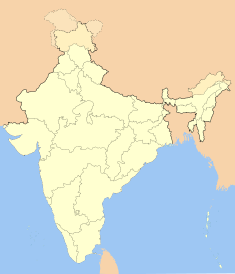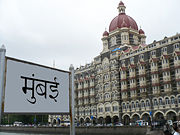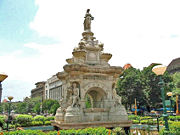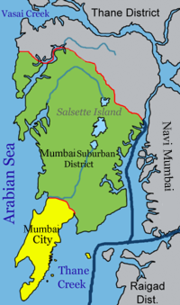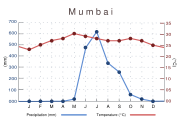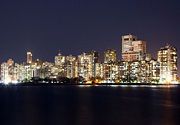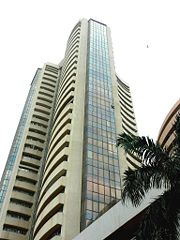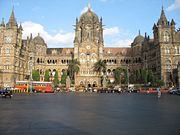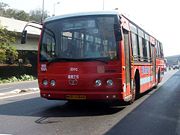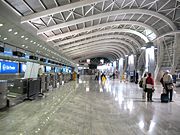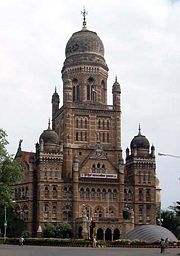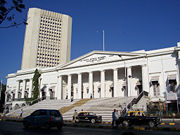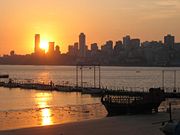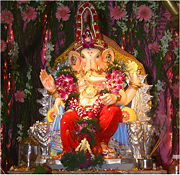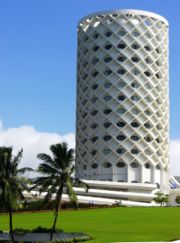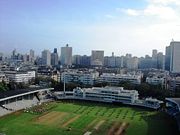Mumbai
2008/9 Schools Wikipedia Selection. Related subjects: Asia; Asian Cities
| ?Mumbai Maharashtra • India |
|
|
|
|
|
|
|
| Coordinates: | |
| Time zone | IST ( UTC+5:30) |
| Area • Elevation |
603.4 km² (233 sq mi) • 8 m (26 ft) |
| District(s) | • Mumbai City • Mumbai Suburban |
| Population • Density |
13.662.885 million ( 1st) ( 2008) • 21,880 /km² (56,669 /sq mi) ( 1st) ( 2008) |
| Municipal commissioner | Jairaj Phatak |
| Mayor | Shubha Raul |
| Codes • Pincode • Telephone • UN/LOCODE • Vehicle |
• 400 xxx • +022 • INBOM • MH 01—04 |
| Website: www.mcgm.gov.in | |
 |
|
Coordinates:
Mumbai ( Marathi: मुंबई, Mumbaī, IPA: /ˈmumbəi/ ), formerly Bombay, is the capital of the Indian state of Maharashtra. With an estimated population of thirteen million, it is the most populous city in the world. Along with the neighbouring suburbs of Navi Mumbai and Thane, it forms, at nineteen million, the world's fifth most populous metropolitan area. Mumbai lies on the west coast of India and has a deep natural harbour. Mumbai's port handles over half of India's maritime cargo.
Mumbai is the commercial and entertainment centre of India, generating 5% of India's GDP and accounting for 25 per cent of industrial output, 40 per cent of maritime trade, and 70 per cent of capital transactions to India's economy. Mumbai is one of the world's top ten centers of commerce by global financial flow, home to such important financial institutions as the Reserve Bank of India, the Bombay Stock Exchange, the National Stock Exchange of India and the corporate headquarters of many Indian companies and numerous multinational corporations. The city also houses India's Hindi film and television industry, known as Bollywood. Mumbai's business opportunities, as well as its high standard of living, attract migrants from all over India and, in turn, make the city a potpourri of many communities and cultures.
Names
The name Mumbai is an eponym, etymologically derived from Mumba or Maha-Amba— the name of the Hindu goddess Mumbadevi, and Aai — mother in Marathi. The former name Bombay had its origins in the 16th century when the Portuguese arrived in the area and called it by various names, which finally took the written form Bombaim, still common in current Portuguese use. After the British gained possession in the 17th century, it was anglicised to Bombay, although it was known as Mumbai or Mambai to Marathi and Gujarati-speakers, and as Bambai in Hindi, Urdu. The name was officially changed to its Marathi pronunciation of Mumbai in 1995.
A widespread explanation of the origin of the traditional English name Bombay holds that it was derived from a Portuguese name meaning good bay. This is based on the fact that bom (masc.) is Portuguese for good whereas the English word bay is similar to the Portuguese baía (fem., bahia in old spelling). The normal Portuguese rendering of good bay would have been boa bahia rather than the grammatically incorrect bom bahia. However, it is possible to find the form baim (masc.) for little bay in sixteenth-century Portuguese.
Other sources have a different origin for the Portuguese toponym Bombaim. José Pedro Machado's Dicionário Onomástico Etimológico da Língua Portuguesa ("Portuguese Dictionary of Onomastics and Etymology") mentions what is probably the first Portuguese reference to the place, dated from 1516, as Benamajambu or Tena-Maiambu, pointing out that "MAIAMBU"' seems to refer to Mumba-Devi, the Hindu goddess after which the place is named in Marathi (Mumbai). In that same century, the spelling seems to have evolved to Mombayn (1525) and then Mombaim (1563). The final form Bombaim appears later in the 16th century, as recorded by Gaspar Correia in his Lendas da Índia ("Legends of India"). J.P. Machado seems to reject the "Bom Bahia" hypothesis, asserting that Portuguese records mentioning the presence of a bay at the place led the English to assume that the noun (bahia, "bay") was an integral part of the Portuguese toponym, hence the English version Bombay, adapted from Portuguese. .
History
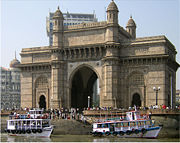
Artefacts found near Kandivali in northern Mumbai indicate that these islands had been inhabited since the Stone Age. Documented evidence of human habitation dates back to 250 BC, when it was known as Heptanesia (Ptolemy) (Ancient Greek: A Cluster of Seven Islands). In the 3rd century BC, the islands formed part of the Maurya Empire, ruled by the Buddhist emperor, Aşoka. During its first few centuries, control over Mumbai was disputed between the Indo-Scythian Western Satraps and the Satavahanas. The Hindu rulers of the Silhara Dynasty later governed the islands until 1343, when the kingdom of Gujarat annexed them. Some of the oldest edifices of the archipelago – the Elephanta Caves and the Walkeshwar temple complex date from this era.
In 1534, the Portuguese appropriated the islands from Bahadur Shah of Gujarat. They were ceded to Charles II of England in 1661, as dowry for Catherine de Braganza. These islands, were in turn leased to the British East India Company in 1668 for a sum of £10 per annum. The company found the deep harbour on the east coast of the islands to be ideal for setting up their first port in the sub-continent. The population quickly rose from 10,000 in 1661, to 60,000 in 1675; In 1687, the British East India Company transferred its headquarters from Surat to Mumbai. The city eventually became the headquarters of the Bombay Presidency. From 1817 onwards, the city was reshaped with large civil engineering projects aimed at merging all the islands in the archipelago into a single amalgamated mass. This project, known as the Hornby Vellard, was completed by 1845, and resulted in the total area swelling to 438 km². In 1853, India's first passenger railway line was established, connecting Mumbai to the town of Thane. During the American Civil War (1861–1865), the city became the world's chief cotton trading market, resulting in a boom in the economy and subsequently enhancing the city's stature.
The opening of the Suez Canal in 1869 transformed Bombay into one of the largest seaports on the Arabian Sea. Over the next thirty years, the city grew into a major urban centre, spurred by an improvement in infrastructure and the construction of many of the city's institutions. The population of the city swelled to one million by 1906, making it the second largest in India after Calcutta. As capital of the Bombay Presidency, it was a major base for the Indian independence movement, with the Quit India Movement called by Mahatma Gandhi in 1942 being its most rubric event. After India's independence in 1947, it became the capital of Bombay State. In the 1950 the city expanded to its present limits by incorporating parts of Salsette island which lay to the north.
After 1955, when the State of Bombay was being re-organised along linguistic lines into the states of Maharashtra and Gujarat, there was a demand that the city be constituted as an autonomous city-state. However, the Samyukta Maharashtra movement opposed this, and insisted that Mumbai be declared the capital of Maharashtra. Following protests in which 105 people were killed by police firing, Maharashtra state was formed with Mumbai as its capital on May 1, 1960.
The late 1970s witnessed a construction boom and a significant influx of migrants, which saw Mumbai overtake Kolkata as India's most populous city. This influx caused unrest among local Maharashtrians who worried about the loss of culture, jobs, and language. The Shiv Sena Party was formed by Balasaheb Thackeray for the purpose of securing the interests of Maharashtrians. The city's secular fabric was torn apart in the riots of 1992–93, after large scale sectarian violence caused extensive loss of life and property. A few months later, on March 12, a series of co-ordinated bombings at several city landmarks by the Mumbai underworld killed around three hundred people. In 1995, the city was renamed Mumbai by the Shiv Sena government of Maharashtra, in keeping with their policy of renaming colonial institutions after historic local appellations. There have also been terrorist attacks, sponsored by Islamic extremists, on public transport buses in past years. In 2006, Mumbai was also the site of a major terrorist attack in which over two hundred people were killed when several bombs exploded almost simultaneously on the Mumbai Suburban Railway.
Geography
Mumbai is located on seven now-merged islands (see seven islands of Bombay) which are Isle of Bombay, Mazagaon, Colaba, Old Woman's Island, Parel, Worli, and Salsette Island. Mumbai lies at the mouth of Ulhas River off the western coast of India, in the coastal region known as the Konkan. Much of Mumbai is just above sea level, and the average elevation ranges from 10 m (33 ft) to 15 m (49 ft). Northern Mumbai is hilly, and the highest point in the city is 450 metres (1,450 feet). Mumbai spans a total area of 603 km² (233 sq mi).
Four lakes supply water to Mumbai: Lakes Vihar, Vaitarna, Tulsi and Tansa. Tulsi Lake and Vihar Lake are located within the metropolitan limits, in Borivili National Park, and supply part of the city's drinking water. The waters of a fifth lake also within the city, Powai, is not used. Mumbai also has three small rivers within the city limits originating in the National Park. The coastline of the city is indented with numerous creeks and bays. The eastern coast of Salsette Island is covered with large mangrove swamps, rich in biodiversity. The western coast is mostly sandy and rocky.
Soil cover in the city region is predominantly sandy due to its proximity to the sea. In the suburbs, the soil cover is largely alluvial and loamy. The underlying rock of the region is composed of black Deccan basalt flows, and their acid and basic variants dating back to the late Cretaceous and early Eocene eras. Mumbai sits on a seismically active zone owing to the presence of three fault lines in the vicinity. The area is classified as a Zone III region, which means an earthquake of up to magnitude 6.5 on the Richter-scale may be expected.
Mumbai is classified as a metropolis of India, under the jurisdiction of the Brihanmumbai Municipal Corporation. It consists of two distinct regions — the city and the suburbs, which also form two separate districts of Maharashtra. The city region is also commonly referred to as the Island City.
Climate
The climate of the city, being in the tropical zone, and near the Arabian Sea, may be broadly classified into two main seasons — the humid season, and the dry season. The humid season, between March and October, is characterized by high humidity and temperatures of over 30 °C (86 °F). Between June and September, the monsoon rains lash the city supplying most of the city's annual rainfall of 2,200 millimetres (86.6 in). The maximum annual rainfall ever recorded was 3,452 millimetres (135.9 in) in 1954. The highest rainfall recorded in a single day was 944 mm (37.16 inches) on 2005- 07-26. The dry season, between November and February, is characterized by moderate levels of humidity and warm to cool weather. Cold northerly winds are responsible for a mild chill during January and February.
Annual temperatures range from a high of 38 °C (100 °F) to a low of 11 °C (52 °F). The record high is 43.3 °C (109.9 °F) and record low is 7.4 °C (45.3 °F) on 1962- 01-22.. Though 7.4 °C (45.3 °F) is the lowest recorded by one of the two official meteorological weather stations, a low of 6.5 °C (43.7 °F) was recorded on February 8, 2008 at a weather station near Kanheri Caves that lies within city limits.
Economy
Mumbai is India's largest city. Mumbai serves as an important economic hub of the country, contributing 10% of all factory employment, 40% of all income tax collections, 60% of all customs duty collections, 20% of all central excise tax collections, 40% of India's foreign trade and 40 billion Rupees (US$ 1 billion) in corporate taxes. Mumbai's per-capita income is Rs.48,954 which is almost three times the national average. Many of India's numerous conglomerates (including State Bank Of India, Tata Group, Godrej and Reliance), and four of the Fortune Global 500 companies are based in Mumbai. Many foreign banks and financial institutions also have branches in this area, the World Trade Centre (Mumbai) being the most prominent one. Up until the 1980s, Mumbai owed its prosperity largely to textile mills and the seaport, but the local economy has since been diversified to include engineering, diamond-polishing, healthcare and information technology. Mumbai is home to the Bhabha Atomic Research Centre, and most of India's specialized, technical industries, having a modern industrial infrastructure and vast, skilled human resources. Rising venture capital firms, start-ups and established brands work in aerospace, optical engineering, medical research, computers and electronic equipment of all varieties, shipbuilding and salvaging, and renewable energy and power.
State and central government employees make up a large percentage of the city's workforce. Mumbai also has a large unskilled and semi-skilled labour population, who primarily earn their livelihood as hawkers, taxi drivers, mechanics and other such blue collar professions. The port and shipping industry, too, employs many residents, directly or indirectly. In Dharavi, in central Mumbai, there is an increasingly large recycling industry, processing recyclable waste from other parts of the city; the district has an estimated 15,000 single-room factories.
The media industry is another major employer in Mumbai. Most of India's major television and satellite networks, as well as its major publishing houses, are headquartered here. The centre of the Hindi movie industry, Bollywood produces the largest number of films per year in the world; and the name Bollywood is a portmanteau of Bombay and Hollywood. Marathi television and Marathi film industry are also based in Mumbai.
Along with the rest of India, Mumbai, its commercial capital, has witnessed an economic boom since the liberalisation of 1991, the finance boom in the mid-nineties and the IT, export, services and BPO boom in this decade. The middle class in Mumbai is the segment most impacted by this boom and is the driver behind the consequent consumer boom. Upward mobility among Mumbaikars has led to a direct increase in consumer spending. Mumbai has been ranked 10th among the world's biggest centres of commerce in terms of financial flow in a survey compiled by Mastercard Worldwide.
Civic administration
The city is administered by the Brihanmumbai Municipal Corporation (BMC) (formerly the Bombay Municipal Corporation), with executive power vested in the Municipal Commissioner, who is an IAS officer appointed by the state government. The Corporation comprises 227 directly elected Councillors representing the twenty four municipal wards, five nominated Councillors, and a titular Mayor. The BMC is in charge of the civic and infrastructure needs of the metropolis. An Assistant Municipal Commissioner oversees each ward for administrative purposes. Almost all the state political parties field candidates in the elections for Councillors. The Mumbai Metropolitan Region consists of 7 Municipal Corporations and 13 Municipal Councils. In addition to the BMC, it includes the Municipal Corporations of Thane, Kalyan - Dombivali, Navi Mumbai, Mira-Bhayandar, Bhiwandi - Nizampur and Ulhasnagar.
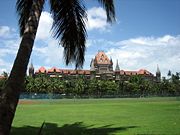
The Greater Mumbai forms two districts of Maharashtra, with each district under the jurisdiction of a District Collector. The Collectors are in charge of property records and revenue collection for the Central Government, and oversee the national elections held in the city.
The Mumbai Police is headed by a Police Commissioner, who is an IPS officer. The Mumbai Police comes under the state Home Ministry. The city is divided into seven police zones and seventeen traffic police zones, each headed by a Deputy Commissioner of Police. The Traffic Police is a semi-autonomous body under the Mumbai Police. The Mumbai Fire Brigade department is headed by the Chief Fire Officer, who is assisted by four Deputy Chief Fire Officers and 6 Divisional Officers.
Mumbai is the seat of the Bombay High Court, which exercises jurisdiction over the states of Maharashtra and Goa, and the Union Territories of Daman and Diu and Dadra and Nagar Haveli. Mumbai also has two lower courts, the Small Causes Court for civil matters, and the Sessions Court for criminal cases. Mumbai also has a special TADA (Terrorist and Disruptive Activities) court for people accused of conspiring and abetting acts of terrorism in the city.
The city elects six members to the Lok Sabha and thirty-four members to the Maharashtra Vidhan Sabha (State assembly). Mumbai is headed by mayor Shubha Raul, Municipal Commissioner Jairaj Phatak, and Sheriff Indu Shahani.
Transport
Most of Mumbai's inhabitants rely on public transport to travel to and from their workplace. Transport systems in Mumbai include the Mumbai Suburban Railway, BEST buses, taxis, auto rickshaws, ferries, and aeroplanes.
The city is the headquarters of two railway zones – the Central Railway (CR) headquartered at Chhatrapati Shivaji Terminus, and the Western Railway (WR) headquartered near Churchgate. The backbone of the city's transport, the Mumbai Suburban Railway, is composed of three separate networks running the length of the city, in a north-south direction. The Mumbai Metro, an underground and elevated railway system that is currently under construction, will run from Versova to Andheri to Ghatkopar when the first phase is completed in 2009. Mumbai is well connected to most parts of India by the Indian Railways. Trains originate from Chhatrapati Shivaji Terminus, Dadar, Lokmanya Tilak Terminus, Mumbai Central and Bandra terminus. Mumbai's suburban rail systems carry a total of 2.2 billion passengers every year, one third of the world's population.
Public buses run by BEST cover almost all parts of the metropolis, as well as parts of Navi Mumbai and Thane. Buses are used for commuting short to medium distances, while train fares are more economical for long distance commutes. The BEST runs a total of 3,400 buses, ferrying 4.5 million passengers over 340 routes. Its fleet consists of single-decker, double-decker, vestibule, low-floor, disabled-friendly, and air-conditioned buses. MSRTC buses provide intercity transport and connect Mumbai with other major cities of Maharashtra and other states. The Mumbai Darshan is a tourist bus service which explores numerous tourist attractions in Mumbai
Black and yellow-metered, taxis traverse most of the metropolis. Auto rickshaws operate in the suburban areas of Mumbai. Rickshaws run on Compressed Natural Gas, are the main form of hired transport. These three-wheeled vehicles are a quick way to get around. They are the cheapest form of hired transport and can accommodate up to three passengers.
Mumbai's Chhatrapati Shivaji International Airport (formerly, Sahar International Airport) is the busiest airport in South Asia. The Juhu aerodrome was India's first airport, and now hosts a flying club and a heliport. The proposed Navi Mumbai International Airport which is to be built in the Kopra-Panvel area, has been sanctioned by the Government and would help relieve the increasing traffic burden on the existing airport. Mumbai handles about 25% of the domestic and 38% of the international air passenger traffic in the country.
With its unique topography, Mumbai has one of the best natural harbours in the world, handling 50% of the country's passenger traffic, and much of India's cargo. It is also an important base for the Indian Navy, being the headquarters of the Western Naval Command. Ferries from Ferry Wharf allow cheap access to islands and beaches in the area.
Utility services
The BMC supplies potable water to the city, most of which comes from the Tulsi and Vihar lakes, as well as a few lakes further north. The water is filtered at Bhandup, which is Asia's largest water filtration plant. Even India's first underground water tunnel will come up in Mumbai. The BMC is also responsible for the road maintenance and garbage collection in the city. Almost all of Mumbai's daily refuse of 7,800 metric tonnes is transported to dumping grounds in Gorai in the northwest, Mulund in the northeast, and Deonar in the east. Sewage treatment is carried out at Worli and Bandra, and disposed off by two independent marine outfalls of 3.4 km (2.1 mi) and 3.7 km (2.3 mi) at Bandra and Worli respectively. A third outfall at Malad is in the planning stages.
Electricity is provided by BEST in the island city, and by Reliance Energy, Tata Power, and Mahavitaran (Maharashtra State Electricity Distribution Co. Ltd) in the suburbs. Most of the city's electricity is hydroelectric and nuclear based. Consumption of electricity is growing faster than production capacity. The largest telephone service provider is the state-owned MTNL, which held a monopoly over fixed line and cellular services up until 2000, and provides fixed line as well as mobile WLL services. Cell phone coverage is extensive, and the main service providers are Vodafone Essar, Airtel, BPL group, Reliance Communications and Tata Indicom. Both GSM and CDMA services are available in the city. Broadband internet penetration is increasing in the city, with MTNL and Tata being the leading service providers.
Since 1995, many parts of the city also have access to piped gas, provided by Mahanagar Gas Limited, which also provides compressed natural gas to 127 gas stations.
Demographics
| Population Growth | |||
|---|---|---|---|
| Census | Pop. | %± | |
| 1971 | 5,970,575 |
|
|
| 1981 | 8,243,405 | 38.1% | |
| 1991 | 9,925,891 | 20.4% | |
| 2001 | 11,914,398 | 20.0% | |
|
Data is based on Government of India Census. |
|||
According to the 2001 census, the population of Mumbai is about 13 million, with the population of the urban agglomerate exceeding 16 million. The Rural Mumbai Metropolitan Region has a population of 1.04 million. As of the 2008 extrapolations carried out by the World Gazetteer, Mumbai has a population of 13,662,885 and the Mumbai Metropolitan Area has a population of 20,870,764. The population density is estimated to be about 22,000 persons per square kilometre. The overall literacy rate of the city is above 86%, higher than the national average. There are 875 females to every 1,000 males – which is lower than the national average.
The religions represented in Mumbai include Hindus (68% of the population), Muslims (17% of the population), and Christians and Jains (4% each). The remainders are Parsis, Buddhists, Sikhs, Jews and Atheists.
According to the 1991 census, the ethnic groups demographics are - Maharashtrians (53%), Gujaratis (22%), North Indians (17%), Tamilians (3%), Sindhis (3%), Tuluvas/ Kannadigas (2%) and others.
Mumbai has a large polyglot population unlike any other metropolitan city of India. Marathi, the official language of Maharashtra state, is widely spoken. Other languages spoken are Hindi and English. A colloquial form of Hindi, known as Bambaiya – a blend of Marathi, Hindi, Indian English and some invented colloquial words are spoken on the streets. English is extensively spoken, and is the principal language of the city's white collar workforce.
Like other metropolises in the developing world, Mumbai suffers from the same major urbanisation problems seen in many fast growing cities in developing countries - widespread poverty and unemployment, poor public health, civic and educational standards for a large section of the population. With available space at a premium, Mumbai residents often reside in cramped, relatively expensive housing, usually far from workplaces, and therefore requiring long commutes on crowded mass transit, or clogged roadways. According to 2001 census of India, about 54% of the city's population lives in slums. Dharavi, Asia's second largest slum is located in central Mumbai and houses over 1 million people. Mumbai recorded 27,577 incidents of crime in 2004, which is down 11% from 30,991 in 2001. The city's main jail is the Arthur Road Jail. The number of migrants to Mumbai from outside Maharashtra during the 1991-2001 decade was 1.12 million, which amounted to 54.8% of the net addition to the population of Mumbai.
People and Culture
A resident of Mumbai is called a Mumbaikar, Mumbaite or Bombayite. Many residents live close to major railway stations for easy access to their workplaces, as a significant amount of time is spent on daily commuting.Mumbai's appetizing foods and cuisines have been influenced by the rich but not too spicy styles of cooking from the surrounding Maharashtra and Gujarat states. Some of the unique and famous palatable specialties include Dhan Sak, Khicheri, Bombli Batata Bhaji, Kamag Kakri, Solachi Kadhi, Min Vela Curry and Curried Bombay Duck. Local roadside fast food includes vada pav, panipuri, paav bhaji, and bhelpuri.
Mumbai is the birthplace of Indian cinema ( Dadasaheb Phalke laid the foundations with his silent movies followed by his Marathi talkies), with the oldest film broadcast here in the early 20th century.Mumbai also boasts of large number of cinemas, including the world's largest IMAX dome theatre, which feature mainstream Bollywood, Marathi and Hollywood movies. Many film festivals are avidly attended throughout the year. Besides catering to cinephiles, the city has a thriving theatrical tradition in Marathi, Hindi, Urdu, English and other regional languages.
Contemporary art is well-represented in both government funded art spaces and private commercial galleries. The government-funded art galleries include The Jehangir Art Gallery and The National Gallery of Modern Art. Built in 1833, the Asiatic Society of Bombay is the oldest public library in the city. The Chhatrapati Shivaji Maharaj Vastu Sangrahalaya (formerly Prince of Wales Museum) is a renowned museum in the heart of South Mumbai near the Gateway of India which houses rare and ancient exhibits of Indian history. Mumbai also has a very popular zoo named Jijamata Udyaan which also harbours a beauteous garden within its boundaries. The city of Mumbai is home to many well known Indian poets.
Mumbai has two UNESCO World Heritage Sites, the Chhatrapati Shivaji Terminus and the Elephanta Caves. The Western Railways is also planning to make a proposal to the UNESCO to include the Churchgate building in the list of World Heritage Sites. Popular places in the city are Nariman Point, Girgaum Chowpatti, Juhu Beach, and Marine Drive. Essel World is an international-style theme park and amusement centre situated close to Gorai Beach. Asia's largest theme water park, Water Kingdom, is also located in Mumbai.
Mumbai residents celebrate Western and Indian festivals with great fanfare. Festivals and celebrations are observed by residents of all communities and religions. Diwali, Holi, Christmas, Navratri, Good Friday, Eid, Dussera, Moharram, Ganesh Chaturthi, Durga Puja and Maha Shivratri are some of the most popular festivals in the city. The Kala Ghoda Festival is an exhibition of a world of arts that encapsulates works of artistes in the fields of music, dance, theatre, film and all the genres of art that make for the vibrantly rich culture of Mumbai. A week long fair known as the Bandra Fair or the Mount Mary Festival is celebrated by people of all faiths. The Banganga Festival is a two-day music festival, held annually in the month of January which is organised by the Maharashtra Tourism Development Corporation (MTDC) at the historic Banganga Tank in Mumbai. The Elephanta Festival which is celebrated every February on the Elephanta Islands, is dedicated to the classical Indian Dance and Music with artists from across the country converging on the occasion conjuring a mesmerizing atmosphere on this picturesque island.
Mumbai has several sister cities:
 Los Angeles, United States
Los Angeles, United States Yokohama, Japan
Yokohama, Japan Stuttgart, Germany
Stuttgart, Germany Berlin, Germany
Berlin, Germany Saint Petersburg, Russia
Saint Petersburg, Russia London, United Kingdom
London, United Kingdom
Education
Schools in Mumbai are either "municipal schools" (run by the BMC) or private schools (run by trusts or individuals), which in some cases receive financial aid from the government. The schools are affiliated either with the Maharashtra State Board (MSBSHSE), the all-India Council for the Indian School Certificate Examinations (CISCE) and the Central Board for Secondary Education (CBSE) boards. Marathi or English is the usual language of instruction. The government run public schools lack many facilities, but are the only option for poorer residents who cannot afford the more expensive private schools. A majority of residents prefer private schools because of better infrastructure and the use of English as a medium of instruction.
Under the 10+2+3/4 plan, students complete ten years of schooling, and then enroll for two years in Junior College, where they select one of three streams: arts, commerce or science. This is followed by either a general degree course in a chosen field of study, or a professional degree course, such as law, engineering, medicine etc. Most colleges in the city are affiliated with the University of Mumbai, one of the largest universities in the world in terms of the number of graduates. The Indian Institute of Technology, Mumbai which is India's premier engineering schools, National Institute of Industrial Engineering [NITIE], VJTI (Veermata Jijabai Technological Institute), SNDT Women's University, and Tata Institute of Social Sciences are the other universities in Mumbai.
Mumbai is home to two of India's important research institutions – The Tata Institute of Fundamental Research ( TIFR),Indian Institute of Technology-Bombay and the Bhabha Atomic Research Centre ( BARC).
Sports
Cricket is the most popular sport in the city, and is usually played in the maidans (grounds) around the city. Gully cricket, a modified form of cricket, is played in the narrow by-lanes of the city. Mumbai is home to the Board of Control for Cricket in India (BCCI). International cricket is widely watched, and the city comes to a virtual standstill on days when the Indian cricket team plays important matches. The local Mumbai cricket team is among the strongest competitors and the most successful team in the Ranji Trophy, the nation's top domestic cricketing circuit. The city is represented by Mumbai Indians in the Indian Premier League, and by Mumbai Champs in the Indian Cricket League. The city has two international cricket stadiums, the Wankhede Stadium and the Brabourne Stadium. The Wankhede stadium is set to host the final of 2011 Cricket World Cup. Eminent cricketers from Mumbai include Sachin Tendulkar, Sunil Gavaskar and Vijay Hazare.
Football is the second most popular sport with the city. The Football World Cup is one of the most widely watched television events in Mumbai. The Mumbai FC (Mumbai Football Club) is one of the renowned Indian football clubs based in Mumbai. India's national sport, field hockey, has gone into decline in the recent years, losing out in terms of popularity to cricket. Mumbai is home to the Maratha Warriors, one of the few teams competing for the Premier Hockey League (PHL) from Maharashtra. Chess is also a very popular indoor sport played in Mumbai. Other sports are mostly played in the numerous clubs and gymkhanas, and include tennis, squash, billiards, badminton, table tennis and golf. Mumbai also plays Rugby union, one of the few Indian cities to do so. Every February, Mumbai holds the Derby races in the Mahalaxmi Racecourse. In recent times Formula 1 racing has also caught on. The Force India team of Formula One has also unveiled its 2008 car in Mumbai. In March 2004, Mumbai Grand Prix was held as part of the F1 powerboat world championship. Other sports such as volleyball and basketball are mostly popular in schools and colleges.
In 2004, the Mumbai Marathon, an annual marathon event, was established in a bid to bring the sport to the Indian public. Since 2006, Mumbai has also played host to the Kingfisher Airlines Tennis Open, an International Series tournament of the ATP Tour. Mcdowell's Derby is held in February at the Turf club in Mumbai.

